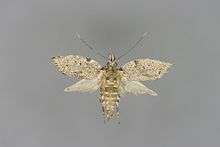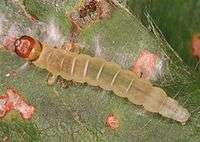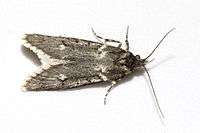Diurnea fagella
The March dagger moth (Diurnea fagella) is a moth of the subfamily Chimabachinae. It is found in Europe and was first described by Michael Denis & Ignaz Schiffermüller in 1775.
| Diurnea fagella | |
|---|---|
 | |
| Male | |
 | |
| Female | |
| Scientific classification | |
| Kingdom: | |
| Phylum: | |
| Class: | |
| Order: | |
| Family: | |
| Subfamily: | |
| Genus: | |
| Species: | D. fagella |
| Binomial name | |
| Diurnea fagella | |
| Synonyms | |
| |
Description
The wingspan of the male is from 26–30 mm and the hindwings are pale grey. The female is smaller with reduced wings and a wingspan of 15–20 mm. Melanic forms are common in both male and female and can be found in some northern and industrial areas of England. In northern Scotland only pale specimens are found and albinistic forms can be found everywhere.[2]
The moth flies in one generation from March to May depending on the location. During the day males rest on tree trunks; the smaller female may be found at nightfall low down on trunks.[3]
- Egg
Eggs are laid from March to May in batches of one hundred or more on the twigs or shoots of many species of deciduous trees and shrubs. Species found are aspen (Populus tremula), beech (Fagus sylvatica), birch (Betula species), blackberry (Rubus fruticosus), blackthorn (Prunus spinosa), bullrush (Typha species), field maple (Acer campestre), hawthorn (Crataegus monogyna), hazel (Corylus avellana), hornbeam (Carpinus betulus), oak (Quercus species), poplar (Populus species) and willow (Salix species).[4]
- Larva
In the final instar larvae are about 25 mm long and can grow to 28 mm. The body is pale greyish green, the head is yellowish orange and the prothoracic plate is translucent green and sometimes there is a faint brown ochre lateral mark. The polyphagous larva feed between leaves which are spun flaty above each other on many deciduous trees and shrubs. They grow very slowly from late-May to September or early-October.[2][4]
- Pupa
Pupation takes place in cocoons found in detritus or the soil from October to March.[2]
Distribution
Found all over Europe, except parts of Russia and Finland.[1]
References
- "Diurnea fagella (Denis & Schiffermüller, 1775)". Fauna Europaea. Retrieved 5 December 2018.
- Emmet, A Maitland; Langmaid, John R; Bland, K P; Fletcher, D S; Harley, B H; Robinson, G S; Skinner, Bernard; Tremewan, W S, eds. (2002). The Moths and Butterflies of Great Britain and Ireland. Volume 4, Part 1. Colchester: Harley Books. pp. 108–10. ISBN 0 946589 66 6.
- Emmet, A M, ed. (1988). A Field Guide To The Smaller British Lepidoptera (Second ed.). London: British Entomological and Natural History Society. p. 113. ISBN 0 9502891 6 7.
- Kimber, Ian. "Diurnea fagella". UKmoths. Retrieved 5 December 2018.
External links
- waarneming.nl (in Dutch)
- Lepidoptera of Belgium
- Diurnea fagella – a common identification puzzle


